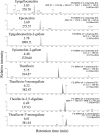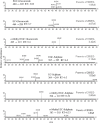Simultaneous Determination of Black Tea-Derived Catechins and Theaflavins in Tissues of Tea Consuming Animals Using Ultra-Performance Liquid-Chromatography Tandem Mass Spectrometry
- PMID: 27695123
- PMCID: PMC5047449
- DOI: 10.1371/journal.pone.0163498
Simultaneous Determination of Black Tea-Derived Catechins and Theaflavins in Tissues of Tea Consuming Animals Using Ultra-Performance Liquid-Chromatography Tandem Mass Spectrometry
Abstract
The bioavailability, tissue distribution and metabolic fate of the major tea polyphenols, catechins and theaflavins as well as their gallated derivatives are yet to be precisely elucidated on a single identification platform for assessment of their relative bioefficacy in vivo. This is primarily due to the lack of suitable analytical tools for their simultaneous determination especially in an in vivo setting, which continues to constrain the evaluation of their relative health beneficiary potential and therefore prospective therapeutic application. Herein, we report a rapid and sensitive Ultra-Performance Liquid Chromatography Tandem Mass Spectrometry (UPLC-MS/MS) based method for the simultaneous determination of the major catechins and theaflavins in black tea infusions as well as in different vital tissues and body fluids of tea-consuming guinea pigs. This method allowed efficient separation of all polyphenols within seven minutes of chromatographic run and had a lower limit of quantification (LLOQ) of ~5 ng/ml. Using this method, almost all bioactive catechins and theaflavins could be simultaneously detected in the plasma of guinea pigs orally administered 5% black tea for 14 days. Our method could further detect the majority of these polyphenols in the lung and kidney as well as identify the major catechin metabolites in the urine of the tea-consuming animals. Overall, our study presents a novel tool for simultaneous detection and quantitation of both catechins and theaflavins in a single detection platform that could potentially enable precise elucidation of their relative bioavailability and bioefficacy as well as true health beneficiary potential in vivo. Such information would ultimately facilitate the accurate designing of therapeutic strategies utilizing high efficacy formulations of tea polyphenols for effective mitigation of oxidative damage and inflammation in humans as well as prevention of associated diseases.
Conflict of interest statement
TG and SM are application scientists, employed by Waters India Pvt. Limited. This is a collaborative study carried out primarily in KP’s lab with assistance from TG and SM. This affiliation had no bearing on the funding of the project which was solely funded by the Tea Board of India, Govt. of India. TG and SM served as application experts to assist in instrument operation and software handling to carry out the relevant analysis with due accuracy. Their contribution in the present work does not in any way violate PLOS One policies on Competing Interests. This does not alter our adherence to PLOS One policies on sharing data and materials.
Figures


Similar articles
-
A sensitive UPLC-MS/MS method for simultaneous determination of polyphenols and theaflavins in rat plasma: Application to a pharmacokinetic study of Da Hong Pao tea.Biomed Chromatogr. 2019 Apr;33(4):e4470. doi: 10.1002/bmc.4470. Epub 2019 Feb 4. Biomed Chromatogr. 2019. PMID: 30585656
-
Simultaneous determination of eight catechins and four theaflavins in green, black and oolong tea using new HPLC-MS-MS method.J Pharm Biomed Anal. 2016 Nov 30;131:140-145. doi: 10.1016/j.jpba.2016.08.020. Epub 2016 Aug 26. J Pharm Biomed Anal. 2016. PMID: 27589031
-
An improved method for the determination of green and black tea polyphenols in biomatrices by high-performance liquid chromatography with coulometric array detection.Anal Biochem. 2000 Mar 15;279(2):164-9. doi: 10.1006/abio.2000.4487. Anal Biochem. 2000. PMID: 10706785
-
[Study of the Stereochemistry and Oxidation Mechanism of Plant Polyphenols, Assisted by Computational Chemistry].Yakugaku Zasshi. 2017;137(3):347-354. doi: 10.1248/yakushi.16-00207. Yakugaku Zasshi. 2017. PMID: 28250332 Review. Japanese.
-
Antioxidative properties of black tea.Prev Med. 2005 Jun;40(6):910-8. doi: 10.1016/j.ypmed.2004.10.014. Prev Med. 2005. PMID: 15850895 Review.
Cited by
-
Quantification of Polyphenols and Metals in Chinese Tea Infusions by Mass Spectrometry.Foods. 2020 Jun 25;9(6):835. doi: 10.3390/foods9060835. Foods. 2020. PMID: 32630507 Free PMC article.
-
Theaflavins, polyphenols of black tea, inhibit entry of hepatitis C virus in cell culture.PLoS One. 2018 Nov 28;13(11):e0198226. doi: 10.1371/journal.pone.0198226. eCollection 2018. PLoS One. 2018. PMID: 30485282 Free PMC article.
-
Tea and tea drinking: China's outstanding contributions to the mankind.Chin Med. 2022 Feb 22;17(1):27. doi: 10.1186/s13020-022-00571-1. Chin Med. 2022. PMID: 35193642 Free PMC article. Review.
-
Quantitative Analysis of Four Catechins from Green Tea Extract in Human Plasma Using Ultra-Performance Liquid Chromatography-Tandem Mass Spectrometry for Pharmacokinetic Studies.Molecules. 2018 Apr 23;23(4):984. doi: 10.3390/molecules23040984. Molecules. 2018. PMID: 29690635 Free PMC article.
-
Microbial Metabolism of Theaflavin-3,3'-digallate and Its Gut Microbiota Composition Modulatory Effects.J Agric Food Chem. 2021 Jan 13;69(1):232-245. doi: 10.1021/acs.jafc.0c06622. Epub 2020 Dec 21. J Agric Food Chem. 2021. PMID: 33347309 Free PMC article.
References
-
- Rietveld A, Wiseman S. Antioxidant effects of tea: evidence from human clinical trials. The Journal of nutrition. 2003;133(10):3285S–92S. - PubMed
-
- Mulder TP, van Platerink CJ, Wijnand Schuyl PJ, van Amelsvoort JM. Analysis of theaflavins in biological fluids using liquid chromatography-electrospray mass spectrometry. Journal of chromatography B, Biomedical sciences and applications. 2001;760(2):271–9. 10.1016/s0378-4347(01)00285-7 - DOI - PubMed
-
- Chhabra SK, Yang CS. Tea and prostate cancer. Epidemiologic reviews. 2001;23(1):106–9. - PubMed
-
- Misra A, Chattopadhyay R, Banerjee S, Chattopadhyay DJ, Chatterjee IB. Black tea prevents cigarette smoke-induced oxidative damage of proteins in guinea pigs. The Journal of nutrition. 2003;133(8):2622–8. - PubMed
MeSH terms
Substances
LinkOut - more resources
Full Text Sources
Other Literature Sources

